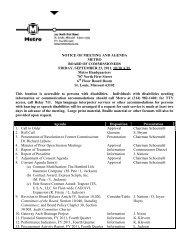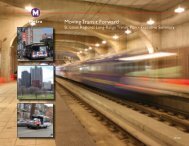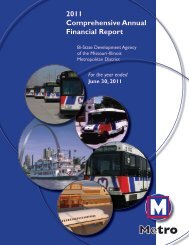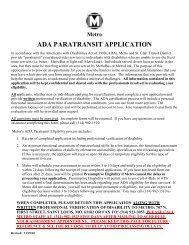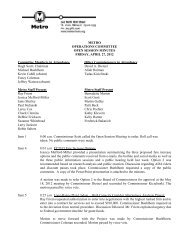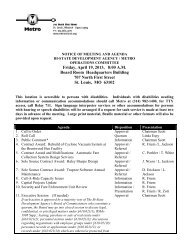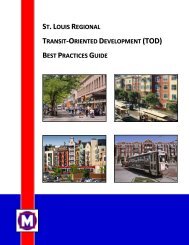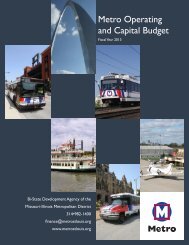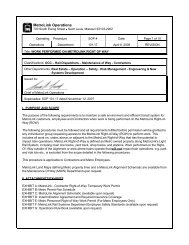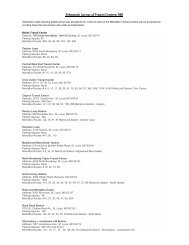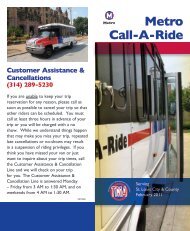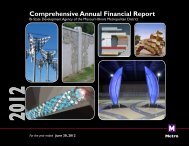THE BI-STATE DEVELOPMENT AGENCY - Metro Transit
THE BI-STATE DEVELOPMENT AGENCY - Metro Transit
THE BI-STATE DEVELOPMENT AGENCY - Metro Transit
You also want an ePaper? Increase the reach of your titles
YUMPU automatically turns print PDFs into web optimized ePapers that Google loves.
<strong>THE</strong> <strong>BI</strong>-<strong>STATE</strong> <strong>DEVELOPMENT</strong> <strong>AGENCY</strong><br />
MAKING AN IMPACT<br />
What we are doing today. How we are preparing for tomorrow.<br />
2013 <strong>STATE</strong> OF <strong>THE</strong> <strong>AGENCY</strong> REPORT<br />
SPECIAL<br />
INSERT TO OT<br />
<strong>THE</strong> EST<br />
ST. LOUIS<br />
BUSINESS S<br />
JOURNAL<br />
SPECIAL INSERT TO <strong>THE</strong> ST. LOUIS BUSINESS JOURNAL
MEASURING OUR IMPACT<br />
How do you measure the Bi-State Development Agency’s impact on the St. Louis region? You could count<br />
the thousands of residents who depend on us to reach their destinations each day. But, that’s just the tip of<br />
the iceberg. Our impact also reverberates through the vibrant communities around busy <strong>Metro</strong>Link stations.<br />
Millions of visitors experience it, too, when they fly into our St. Louis Downtown Airport, take a tram ride in<br />
the Gateway Arch or patronize any of the other riverfront attractions we operate. We are, at root, an economic<br />
development agency. In all we do, whether it’s transit, aviation or tourism, we seek to make a positive impact<br />
on our region’s vitality and long-term sustainability.<br />
“ Our vision is to improve the region’s quality<br />
of life by providing excellent transportation<br />
and promoting economic development.”<br />
DEAR FRIENDS,<br />
The impact of the Bi-State Development Agency on the St. Louis region goes<br />
far beyond the 46 million boardings we provided to <strong>Metro</strong>Bus, <strong>Metro</strong>Link and<br />
<strong>Metro</strong> Call-A-Ride customers in 2012.<br />
Most people, in fact, don’t know that Bi-State was founded in 1949, not as<br />
a transit authority, but as an economic development agency charged with<br />
the mission of solving regional problems. We got into the transit business in<br />
1963, at the request of civic and business leaders, when it became apparent<br />
that our local economy needed a stable, reliable bus system to serve the<br />
region. That was 50 years ago this month. Since then, we have grown an<br />
award-winning transit system that travels more than 500 square miles with<br />
light rail, van and bus.<br />
Today, the Bi-State Development Agency is comprised of three distinct, but<br />
interrelated businesses:<br />
• <strong>Metro</strong> <strong>Transit</strong> – Our transit operations include <strong>Metro</strong>Bus, a 75-route<br />
bus system; <strong>Metro</strong>Link, a two-line, 37-station light rail system; and <strong>Metro</strong><br />
Call-A-Ride, a curb-to-curb paratransit van service for St. Louis City and<br />
County customers who are unable to use regular bus and light rail service.<br />
• The St. Louis Downtown Airport – Located in Cahokia, Ill., just three<br />
miles from the St. Louis Riverfront, this business and private aviation<br />
airport has grown to be the third busiest airport in Illinois. It has been<br />
owned and operated by Bi-State since 1965.<br />
• Tourism – Bi-State oversees the operation of a number of high-profile<br />
community assets in addition to the St. Louis Downtown Airport. Other<br />
business enterprises include the Tom Sawyer and Becky Thatcher<br />
Riverboats, the Arch View Café, the Riverfront Bike Rental and Heliport<br />
operations, operating the tram rides at the Gateway Arch and operating<br />
the Arch Parking Facility. We also have an ownership interest in and<br />
are responsible for maintaining all except the road deck of the historic<br />
Eads Bridge.<br />
ANNIVERSARIES<br />
50<br />
YEARS<br />
<strong>Metro</strong>Bus<br />
April 2013<br />
25<br />
YEARS<br />
Call-A-Ride<br />
Nov. 2012<br />
20<br />
YEARS<br />
<strong>Metro</strong>Link<br />
July 2013<br />
David A. Dietzel<br />
Only the transit business is partially supported by local public funds.<br />
Each one of these businesses supports the others, while fueling the local<br />
economy. Our region’s St. Louis downtown riverfront assets attract tourists<br />
to our area, while our transit system enables them and our residents to get<br />
where they need to go. Our <strong>Metro</strong>Link stations, meanwhile, are themselves<br />
becoming a magnet for new residential and commercial development,<br />
job creation and economic growth (see page 3), as we see in new<br />
places like the Mercantile Exchange downtown and more established areas<br />
like Emerson Park in East St. Louis.<br />
From our efforts to create a smarter, safer transit system (see page 5), to<br />
our leadership roles on the Regional Plan for Sustainable Development<br />
and St. Louis Rapid <strong>Transit</strong> Connector study (see page 7), we continue<br />
to explore ways to make a meaningful impact on the St. Louis <strong>Metro</strong>politan<br />
area. Given the instability of federal funding, we work hard to compete for<br />
those funds to benefi t our region and then strive to create the most value for<br />
our economic development dollar.<br />
As we move forward, we are committed to continuing to be a good<br />
investment for our region, and stewards of the funds entrusted to us. We<br />
will remain focused on developing regional solutions to the challenges our<br />
community faces.<br />
We thank you for the opportunity to serve you, and look forward to making<br />
the region even better in the years ahead.<br />
David A. Dietzel<br />
Chairman, Board of Commissioners<br />
John M. Nations<br />
John M. Nations<br />
President & CEO<br />
2 Bi-State Development Agency SPECIAL INSERT TO <strong>THE</strong> ST. LOUIS BUSINESS JOURNAL
MAKING AN IMPACT: ON OUR REGION<br />
Public transportation and economic development are like two sides of<br />
the same coin. You can’t have one without the other. But which came<br />
first? For Bi-State, it was economic development. Since our creation in<br />
1949 as one of the nation’s first interstate agencies, our mission has<br />
been to foster development on both sides of the Mississippi River. We<br />
have been a regional problem solver ever since, active in everything<br />
from early interstate highway planning, to the establishment of the<br />
St. Louis <strong>Metro</strong>politan Sewer District, to the re-opening of the old Parks<br />
Airport which is now the St. Louis Downtown Airport.<br />
Even the regional mass transit system we operate, and are best<br />
known for today, was created to bolster our economy. Our <strong>Metro</strong>Link<br />
stations and other infrastructure have become magnets for new<br />
development.<br />
What kind of impact can mass transit have on a community? It<br />
can make a neighborhood or shopping area more accessible.<br />
It can be the seed that spurs a community to grow and prosper.<br />
It’s happening here. And these are just a few examples:<br />
• Located near the Convention Center <strong>Metro</strong>Link Station, the<br />
Mercantile Exchange has attracted a new movie theater and<br />
restaurants, while linking downtown’s most vibrant residential,<br />
shopping and entertainment neighborhoods.<br />
• When the <strong>Metro</strong>Link station at Emerson Park opened in 2001, the<br />
development of Parson’s Place created a vibrant, new residential<br />
neighborhood. Today, the $22 million Jazz at Walter Circle<br />
senior housing development is under construction.<br />
• The Meridian at Brentwood includes offi ce, residential,<br />
restaurant and retail space, all within walking distance<br />
of the Brentwood <strong>Metro</strong>Link Station.<br />
City / County Residents<br />
Work Locations<br />
In the St. Louis <strong>Metro</strong>politan area, 95% of residents live within walking<br />
distance – that’s three-quarters of a mile – to transit that reaches about<br />
95% of the work locations in our service area.<br />
Jazz at Walter Circle<br />
East St. Louis, IL<br />
Mercantile Exchange<br />
Downtown St. Louis, MO<br />
The Meridian at Brentwood<br />
Brentwood, MO<br />
More than 900,000 visitors rode the tram to the top of the Gateway<br />
Arch in 2012. That’s a 7.7% increase over 2011, since Bi-State<br />
worked with the National Park Service to update the Visitor Center<br />
with renovations to the security checkpoints, visitor information<br />
area and ticketing center. Bi-State is responsible for operating the<br />
Arch transportation and ticketing systems.<br />
DID YOU KNOW?<br />
Bi-State Operates an Asset Worth Over<br />
a Half-Billion Dollars to the <strong>Metro</strong> East<br />
Owned and operated by Bi-State, the St. Louis Downtown Airport hosted 90,000 take offs and landings<br />
last year, on flights that carried sports teams, politicians, entertainers and business professionals. It<br />
is the second busiest airport in the St. Louis area and the third busiest in Illinois, behind O’Hare and<br />
Midway in Chicago. Bi-State has owned and operated this important community asset since 1965.<br />
But what does that mean to the region’s economy? It means high-paying jobs in the <strong>Metro</strong> East<br />
and sound aviation-related businesses in the area. What was once a shuttered airport, and a field<br />
overgrown with weeds, now provides $584 million in annual economic benefit to the local economy.<br />
SPECIAL INSERT TO <strong>THE</strong> ST. LOUIS BUSINESS JOURNAL<br />
State of the Agency 3
MAKING AN IMPACT: ON OUR CUSTOMERS<br />
Each day, <strong>Metro</strong> <strong>Transit</strong>’s buses, trains and vans are boarded more than<br />
100,000 times from several thousand locations. Our riders are traveling<br />
from as far as Wildwood and Eureka in Missouri, to Scott Air Force<br />
Base in Illinois. Three out of four are heading to and from work. Another<br />
15% rely on us to get to school, with the remainder going to shopping<br />
centers, medical appointments, sporting events, concerts, religious<br />
services and countless other destinations.<br />
But <strong>Metro</strong>Bus and <strong>Metro</strong>Link aren’t just for the people who use<br />
public transportation. They’re also for the owners of the businesses<br />
that employ these individuals and the customers who patronize them.<br />
In other words, 8% of our region may use our transit system, but 100%<br />
of the region depends on public transit to bring workers, customers,<br />
patients and clients to the door.<br />
With nearly 400 <strong>Metro</strong>Bus vehicles on the road, more than 21 hours a day, the safety<br />
of our passengers and employees is our greatest concern. Over the past seven years,<br />
we have cut our transit accident rate in half. How did we do it? Ongoing driver training<br />
programs, as well as other preventive measures helped us to maximize safety on the<br />
road. In 2012, we achieved record-high customer satisfaction as well, thanks in large<br />
part to initiatives to improve safety, reliability and comfort – the things our riders<br />
value most.<br />
DID YOU KNOW?<br />
<strong>Metro</strong> <strong>Transit</strong><br />
“Graduates”<br />
Thousands<br />
of Riders<br />
Each Year<br />
Our ridership is always changing.<br />
We estimate that roughly 2%<br />
of our riders who use transit to<br />
further their education find that<br />
they increase their earning power<br />
and increase their transportation<br />
options. While some move on,<br />
many continue to use public transit<br />
because they appreciate the cost<br />
savings and “green value” of<br />
transit. We are proud to be a part<br />
of their success.<br />
The #56 Kirkwood-Webster <strong>Metro</strong>Bus stop at West Lockwood<br />
Avenue and Austin Place is no ordinary bus stop. It’s Grace<br />
Mehan’s bus stop in Glendale, and it is one of the best decorated<br />
stops in town.<br />
Airports create jobs, and jobs lead to opportunity.<br />
That is certainly true of the St. Louis Downtown<br />
Airport, which not only serves as our city’s front<br />
door for private and business aviation, but is also<br />
home to 26 businesses, including Jet Aviation, a<br />
General Dynamics subsidiary that provides aircraft<br />
maintenance, modifications and refurbishments.<br />
“Instead of trying to compete for each other’s piece<br />
of the economic pie, regional airports benefit by<br />
working together to make the whole pie bigger,” says<br />
Dr. Susan Shea, Director of the Illinois Department<br />
of Transportation’s Division of Aeronautics. In all,<br />
Illinois airports contribute $40.9 billion to the state’s<br />
economy and are responsible for more than 337,000<br />
jobs, according to a statewide aviation economic<br />
impact study.<br />
It’s here that Grace, a Glendale resident with Down syndrome,<br />
boards the bus each weekday for the Special School District<br />
program she attends at Webster University and her hostess job<br />
at a Kirkwood restaurant.<br />
From shamrocks on St. Patrick’s Day, to turkeys at Thanksgiving,<br />
the bus stop’s lavish homemade decorations are a celebration of<br />
Grace’s independence, say her parents, Tom and Colleen. “When<br />
Grace graduated from high school, her goal was to get around<br />
town on her own,” says Tom. “The bus not only enables Grace to<br />
get from place to place, but it shows she is a typical citizen and<br />
member of our community.”<br />
4 Bi-State Development Agency<br />
SPECIAL INSERT TO <strong>THE</strong> ST. LOUIS BUSINESS JOURNAL
MAKING AN IMPACT: ON OUR ASSETS<br />
Keeping your equipment in top working order is more than just good<br />
common sense. It’s also good business sense. Well-maintained assets<br />
translate into longer operating life, greater reliability, increased usage<br />
and greater customer satisfaction.<br />
Bi-State is responsible for the operation and maintenance of more<br />
than $2 billion in community assets, including a fleet of 374 buses,<br />
121 vans and 87 trains; the stations, tracks and other infrastructure<br />
that support them; the Eads Bridge; St. Louis Downtown Airport, the<br />
riverfront attractions and a host of other facilities entrusted to our care.<br />
In the years since we adopted a predictive, preventive maintenance<br />
program, <strong>Metro</strong>Bus and <strong>Metro</strong>Link performance has experienced<br />
steady improvement. In 2012, our satellite tracking system found that<br />
our transit system recorded an on-time percentage of 93.6%, up from<br />
approximately 60% in 1999, when we began implementing these<br />
systems and tracking results.<br />
DID YOU KNOW?<br />
The cost of keeping a bus in service averages $130 per hour in transit systems<br />
similar to <strong>Metro</strong>’s. <strong>Metro</strong> keeps costs among the lowest in the nation at less<br />
than $100 per mile. We keep our costs low with the innovations and expertise<br />
of our award-winning maintenance team. When you are transporting customers<br />
more than 7,500 hours per year, that number adds up.<br />
Peer Comparison – Motor Bus<br />
Vehicle Maintenance Cost per Mile (Including Fuel)<br />
$4.0<br />
3.5<br />
3.0<br />
2.5<br />
Our Buses Last<br />
50% Longer<br />
In cities across America, mass transit buses have an<br />
average life span of 10 years or 500,000 miles. That sounds<br />
pretty good, until you consider <strong>Metro</strong>’s buses last, on<br />
average, 50% longer – 15 years or 750,000 miles.<br />
Our buses last longer because of the proactive maintenance<br />
approach we use to keep them in top working order. We<br />
continuously monitor our onboard computer systems for<br />
data. Let’s say the computer tells us that a bus door is<br />
taking longer than average to close. The system alerts<br />
our maintenance department with an email, so we can<br />
schedule maintenance before the door becomes an issue.<br />
2.0<br />
1.5<br />
1.0<br />
0.5<br />
0.0<br />
San Diego<br />
Denver<br />
St. Louis<br />
Sacramento<br />
Dallas<br />
Cleveland<br />
Buffalo<br />
Portland<br />
Baltimore<br />
Pittsburgh<br />
San Jose<br />
By attending to details like this, we not only make the<br />
bus system last longer, but we dramatically increase<br />
bus reliability. The industry averages one breakdown<br />
every 5,000 miles. Each <strong>Metro</strong>Bus, on average, travels<br />
more than 27,000 miles between failures, resulting<br />
in reduced maintenance costs and service reliability<br />
unheard of anywhere else in our industry.<br />
Before the Gateway Arch rose in the sky as an iconic<br />
symbol of westward expansion, the St. Louis riverfront<br />
was best known for the Eads Bridge, a marvel of<br />
modern engineering. Jointly owned by Bi-State and<br />
the City of St. Louis, the national landmark carries<br />
thousands of cars per day. <strong>Metro</strong>Link trains use the<br />
bridge to cross the Mississippi River more than 300<br />
times each weekday.<br />
Today, the 139-year-old bridge is one year into a<br />
three-year, multi-million dollar repair and modernization<br />
project to prepare it for another half century of service.<br />
Riders will soon be able to board our buses and trains<br />
faster, thanks to the phasing in of a new fare collection<br />
system. Old fareboxes on buses are being replaced, while<br />
new ticket vending machines, new fareboxes and an<br />
upgraded ticket validation system are being installed.<br />
We’re also upgrading g our infrastructure to implement<br />
future “smart” amenities that will<br />
allow customers to use smart<br />
cards rather than cash or passes,<br />
use their cell phones to track<br />
bus locations,<br />
calculate wait<br />
periods, and more.<br />
SPECIAL INSERT TO <strong>THE</strong> ST. LOUIS BUSINESS JOURNAL State of the Agency 5
MAKING AN IMPACT: ON OUR COMMUNITY<br />
Whether it’s construction jobs, attracting visitors and tourism dollars or<br />
providing public transit, Bi-State impacts our community. For example,<br />
our best known company, <strong>Metro</strong>, boards an average of 148,000<br />
passengers on an average weekday, and focuses on creating a system<br />
that brings riders and routes together to facilitate convenient and<br />
timely transfers, whether they’re traveling by bus, train or van.<br />
Our use of a “hub-and-spoke” transit network not only speeds<br />
transfers and improves convenience for many customers, it allows us<br />
to make better use of our transportation resources. Buses, for example,<br />
are more likely to operate at full capacity, and can often complete more<br />
trips each day. New spokes can also be created with relative ease.<br />
These improvements impact not just our system, but overall customer<br />
satisfaction as well.<br />
Nineteen percent of <strong>Metro</strong>Bus riders live within fi ve miles of 4140 Pershall Road in Ferguson.<br />
That is where construction is set to begin in early 2014 at the new North County <strong>Metro</strong>Bus<br />
<strong>Transit</strong> Center, a hub facility where most North County routes will converge. The new transit<br />
center is scheduled for completion in early 2015. Expansion of the Civic Center <strong>Metro</strong>Bus<br />
<strong>Transit</strong> Center at 14th Street between Spruce and Clark is also being planned.<br />
Both transit centers will include climate-controlled waiting areas and other customer amenities.<br />
Both are being designed to better serve riders in these strong and growing transit markets.<br />
DID YOU KNOW?<br />
Bi-State Operates the Many<br />
Attractions on the Riverfront<br />
Locals may associate Bi-State with our transit system, but visitors become<br />
acquainted with us as the operators of the Gateway Arch tram rides, Tom<br />
Sawyer and Becky Thatcher Riverboats, the Arch View Café, Arch Parking<br />
Facility and Riverfront Bike Rentals and Heliport. We proudly support<br />
tourism in our region through our operation and maintenance of these<br />
important community assets.<br />
Passenger fares cover approximately 22% of <strong>Metro</strong> <strong>Transit</strong>’s annual<br />
operating costs (excluding depreciation). We rely on local sales<br />
tax revenue, as well as federal and state funding to subsidize<br />
the remainder of our operating costs and to modernize our fare<br />
collection system, construct new bike trails and implement other<br />
capital projects identifi ed in Moving <strong>Transit</strong> Forward, the 30-year<br />
transit blueprint for our region.<br />
As competition for limited federal funding increases, we are<br />
exploring creative, alternate fi nancing approaches, including<br />
public-private partnerships with developers interested in pursuing<br />
transit-oriented development opportunities. Through our continuous<br />
improvement programs, we also continue to capitalize on the cost<br />
savings associated with operating an effi cient, well-maintained<br />
transit system. We are working hard to make sure that every dollar<br />
achieves maximum impact.<br />
Revenue Sources by Detail<br />
(in millions)<br />
It’s become even easier to “Bike St. Clair County” since the newest section of the<br />
county’s <strong>Metro</strong>BikeLink Trail, funded in partnership with the St. Clair County <strong>Transit</strong><br />
District, opened last fall. The 2.2 mile extension runs from the Swansea <strong>Metro</strong>Link<br />
Station to the Memorial Hospital <strong>Metro</strong>Link Station in Belleville. The trail, which<br />
parallels the <strong>Metro</strong>Link system, is now nearly seven miles long and extends to Belleville’s<br />
North End Park. And in Missouri, Bi-State received a $1 million grant in 2012 to make<br />
improvements to a section of the 11-mile St. Louis Riverfront Trail, a bicycle trail that<br />
starts below the Gateway Arch along Lenor K. Sullivan Boulevard and parallels the<br />
Mississippi River as it runs north to North Riverfront Park. Funding was provided by the<br />
U.S. Department of Transportation/FTA Paul S. Sarbanes <strong>Transit</strong> in Parks Program.<br />
$50.3<br />
$4.0<br />
$40.5<br />
$3.8<br />
$21.5<br />
$2.0<br />
$5.4<br />
$134.0<br />
Local Missouri<br />
Sales Tax<br />
Federal<br />
Operating<br />
Assistance<br />
Paratransit<br />
Contracts<br />
St. Clair<br />
County TD<br />
Total Annual Revenue: $261.5 million<br />
Other<br />
Operating<br />
Revenue<br />
Passenger<br />
Revenue<br />
Other Non-<br />
Operating<br />
Revenue<br />
Interest<br />
Revenue<br />
6 Bi-State Development Agency SPECIAL INSERT TO <strong>THE</strong> ST. LOUIS BUSINESS JOURNAL
MAKING AN IMPACT: ON OUR FUTURE<br />
What does the future hold for St. Louis? What kinds of new businesses<br />
will we attract? Where will new development take root? What initiatives<br />
should the region pursue now to support the health and vitality of its<br />
residents and the long-term sustainability of both its resources and its<br />
economy? These are questions that Bi-State is studying and, in many<br />
cases, helping to address through the projects we undertake and support.<br />
As a partner in our region’s economic development, we eagerly<br />
seek opportunities to collaborate with others on the solutions to<br />
these challenges. Our goal: to pool our region’s potential solutions<br />
in forward-thinking ways that create the greatest positive long-term<br />
impact on our future.<br />
Imagine <strong>Metro</strong>Bus riders in downtown St. Louis boarding high capacity,<br />
articulated buses during peak hours, or next-generation buses that traverse<br />
Interstate Highways, rather than slower moving streets, to help riders from<br />
outlying areas reach their destinations faster. Both are among the concepts<br />
being explored through the St. Louis Rapid <strong>Transit</strong> Connector Study that<br />
Bi-State is now completing in partnership with East-West Gateway Council<br />
of Governments, St. Louis City and County, and the Missouri Department<br />
of Transportation.<br />
What does it mean to be a “sustainable community?” In St. Louis, it<br />
means expanding our economy and growing our population in ways that<br />
preserve the environment and foster social equity. It means planning<br />
future development in ways that support the land, water, air and other<br />
natural resources available to us. To Bi-State, it means providing<br />
more transportation choices, especially “green” ones that reduce the<br />
consumption of fossil fuels, and leveraging our investments in ways that<br />
enhance our region’s competitiveness.<br />
Scheduled for completion in September 2013, the study’s first phase looks<br />
at potential transit investments along four interstate corridors – I-64, I-44,<br />
I-55 and I-70. Drawing on community input and technical analysis, we will<br />
identify two transit projects that enhance mobility for large segments of our<br />
region’s population, contribute to economic development and expand the<br />
quality and effi ciency of the St. Louis regional transit system. As we move<br />
forward, we will seek the federal funding the region needs to support these<br />
major transit projects.<br />
Bi-State is an active partner in the planning for the CORTEX development.<br />
Situated in midtown St. Louis, the CORTEX project is being built to<br />
accommodate the growing life sciences sector of our economy, and<br />
public transit is playing a central role in how this new community will<br />
move forward.<br />
Building a sustainable community is an effort that requires both public and<br />
private commitment. That’s why we are one of 11 core partners leading<br />
hundreds of public and private groups in the development of a Regional<br />
Plan for Sustainable Development. Funded through the U.S. Department<br />
of Housing and Urban Development’s Sustainable Communities Initiative,<br />
the three-year planning process includes, among other things, a study of<br />
<strong>Transit</strong>-Oriented Development (TOD) opportunities. TOD is an approach that<br />
mixes housing, offi ce, retail and other amenities into compact, walkable<br />
communities centered around high quality public transportation like ours.<br />
SPECIAL INSERT TO <strong>THE</strong> ST. LOUIS BUSINESS JOURNAL<br />
State of the Agency 7
FINANCIAL HIGHLIGHTS<br />
This year began with, for the public sector, groundbreaking, cost saving<br />
measures that will better manage health care and retirement costs<br />
over time. Our tourism businesses, including Arch tram ticket sales<br />
and Gateway Arch Riverboat sales, benefited from the slight upturn in<br />
the economy and better weather-related conditions on the Mississippi<br />
River. St. Louis Downtown Airport has become a hub for medical fl ights.<br />
St., Louis Children’s Hospital helicopters are now based at our airport,<br />
and other medical and emergency helicopters are using our airport<br />
as an important refueling site. <strong>Metro</strong> <strong>Transit</strong> experienced positive<br />
operational and financial trends in 2012 and was recognized by the<br />
American Public <strong>Transit</strong> Association in the first and third quarters<br />
of 2012 as the transit system with the faster growing bus ridership<br />
base in the country. Customers have continued to respond to<br />
improvements in transit service with ridership reaching more than<br />
46.7 million trips in 2012, an increase of 8.6% over the previous<br />
year and a 3.1% increase for the first six months of FY 2013.<br />
METRO<br />
TRANSIT<br />
ARCH TRAM<br />
SYSTEM<br />
ARCH<br />
PARKING<br />
FACILITY<br />
RIVERFRONT<br />
ATTRACTIONS<br />
ST. LOUIS<br />
DOWNTOWN<br />
AIRPORT<br />
EXECUTIVE<br />
SERVICES<br />
TOTAL<br />
For the Year Ended June 30, 2012<br />
OPERATING REVENUES<br />
Passenger and service revenues $ 50,296,567 $ 5,844,419 $1,595,752 $2,474,040 $ 1,195,479 $ - $ 61,406,257<br />
Other operating revenue 3,976,026 (26,172) 47,169 (6,267) 221,797 3,124,000 7,336,553<br />
Total operating revenues 54,272,593 5,818,247 1,642,921 2,467,773 1,417,276 3,124,000 68,742,810<br />
OPERATING EXPENSES<br />
Wages and benefits 152,964,104 1,411,262 367,010 1,154,711 823,294 2,014,234 158,734,615<br />
Services 27,694,579 778,561 515,080 248,398 27,913 575,451 29,839,982<br />
Materials, supplies, and fuel 35,813,904 145,891 39,334 550,116 124,341 16,090 36,689,676<br />
Casualty and liability insurance 3,504,566 36,656 29,824 146,813 9,413 - 3,727,272<br />
Administrative charges 1,800,000 650,529 146,910 - 70,877 - 2,668,316<br />
Utilities, leases, and general expenses 8,435,755 562,660 74,681 272,364 169,704 225,436 9,740,600<br />
Depreciation and amortization 71,680,383 403,798 85,441 256,972 1,790,902 2,831 74,220,327<br />
Total operating expenses 301,893,291 3,989,357 1,258,280 2,629,374 3,016,444 2,834,042 315,620,788<br />
OPERATING INCOME (LOSS) (247,620,698) 1,828,890 384,641 (161,601) (1,599,168) 289,958 (246,877,978)<br />
NON-OPERATING REVENUE (EXPENSE)<br />
Total non-operating revenue (exp) 178,619,476 (674,509) (63,953) 115 1,034 1,650 177,883,813<br />
INCOME (LOSS) BEFORE CAPITAL CONTRIBUTIONS (69,001,222) 1,154,381 320,688 (161,486) (1,598,134) 291,608 (68,994,165)<br />
Capital contributions 77,577,116 - - - 6,378,651 - 83,955,767<br />
Change in net assets 8,575,894 1,154,381 320,688 (161,486) 4,780,517 291,608 14,961,602<br />
Total net assets, beginning of the year 619,304,501 12,846,967 1,859,207 1,498,662 21,855,635 1,265,916 658,630,888<br />
Total net assets, end of the year $627,880,395 $14,001,348 $2,179,895 $1,337,176 $26,636,152 $1,557,524 $673,592,490<br />
Please refer to www.metrostlouis.org > About > Financial Information for a complete set of 2012 audited financial reports.<br />
BOARD OF COMMISSIONERS<br />
Bi-State’s 10-member Board provides overall leadership and policy<br />
direction for the Agency, and is comprised of five members from<br />
Missouri and five from Illinois. In Missouri, members are selected<br />
by the Governor from recommendations by the Mayor of the City of<br />
St. Louis and the St. Louis County Executive. In Illinois, the Chairmen<br />
of the County Board for both St. Clair and Madison counties appoint<br />
their representatives. Members of the Board serve 5-year terms<br />
without compensation and must be a resident voter of their state<br />
as well as reside within the bi-state metropolitan region.<br />
DAVID DIETZEL<br />
<strong>Metro</strong> Board Chairman,<br />
Madison County, Illinois<br />
Part-time consultant for SCI<br />
Engineering in a business<br />
development capacity and<br />
former County Engineer for<br />
Madison County<br />
MICHAEL BUEHLHORN<br />
Treasurer,<br />
St. Clair County, Illinois<br />
Executive Director of the<br />
<strong>Metro</strong> East Park and<br />
Recreation District<br />
KEVIN CAHILL<br />
Secretary,<br />
St. Louis County, Missouri<br />
Director of Investment<br />
Banking for Edward Jones<br />
FONZY COLEMAN<br />
St. Clair County, Illinois<br />
Retired educator with over<br />
34 years of educational<br />
administrative and teaching<br />
experience from the East St.<br />
Louis School District #189<br />
CONSTANCE GULLY<br />
Vice Chair,<br />
St. Louis County, Missouri<br />
Vice President for Business<br />
and Financial Affairs at<br />
Harris-Stowe State University<br />
ALIAH HOLMAN<br />
St. Louis City, Missouri<br />
Senior Marketing Manager<br />
for Express Scripts<br />
TADAS KICIELINSKI<br />
Madison County, Illinois<br />
General Vice President<br />
Ironworkers International, &<br />
President, St. Louis & Vicinity<br />
District Council<br />
VINCENT SCHOEMEHL JR.<br />
St. Louis City, Missouri<br />
President and CEO<br />
of Grand Center, Inc.<br />
HUGH SCOTT III<br />
St. Louis County, Missouri<br />
Retired Managing Director<br />
of Investment Banking at<br />
Stifel Nicolaus, Inc.<br />
JEFFREY WATSON<br />
St. Clair County, Illinois<br />
General Manager and General<br />
Counsel for the Casino Queen<br />
<strong>BI</strong>-<strong>STATE</strong> <strong>DEVELOPMENT</strong> <strong>AGENCY</strong> • 707 N. 1ST STREET, ST. LOUIS, MO 63102 • WWW.METROSTLOUIS.ORG<br />
8 Bi-State Development Agency SPECIAL INSERT TO <strong>THE</strong> ST. LOUIS BUSINESS JOURNAL



